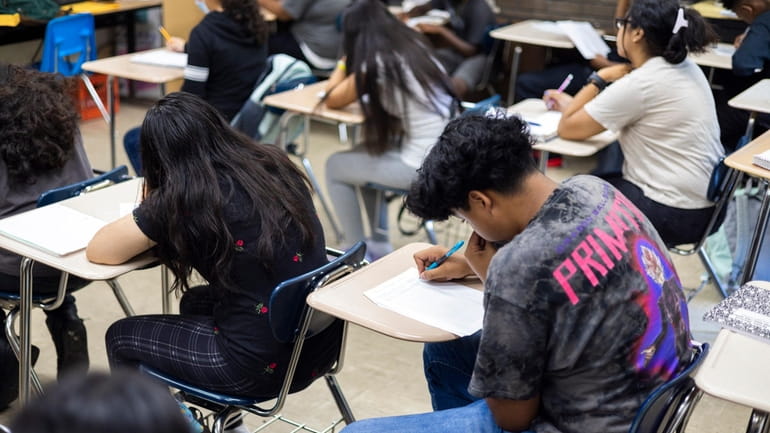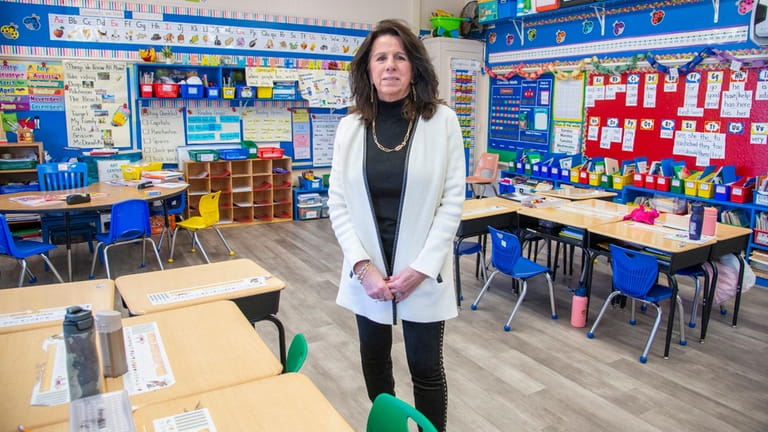Coming to Long Island schools: record-breaking $775M increase in state aid

Students do their work in Historical Research during summer school classes at Hempstead High School last July. Credit: Corey Sipkin
Long Island's public schools next school year can look forward to what educators call a record-breaking $775 million expansion in state financial aid, a Newsday analysis found.
The aid proposal for 2023-24 is part of a statewide $3.1 billion increase for schools announced Wednesday by Gov. Kathy Hochul. The extra money would be on top of two other large appropriations for the Nassau-Suffolk region: an additional $417 million in 2021-22, and $457 million this school year.
The latest plan would spread new aid money widely. Newsday's review found that about 80 districts out of 121 included in the distribution would get dollar increases of at least 10% each — welcome relief to help meet inflationary rises in education costs.
"It is 100 percent the largest increase that I've seen in the 20 years I've been doing this," said one finance expert, Ryan Ruf, chief operating officer of the regional Eastern Suffolk BOCES, headquartered in Patchogue. He went on to describe Hochul's proposal as "unprecedented" support that would have "an immediate impact in classrooms on Long Island and across New York State."
WHAT TO KNOW
- Long Island schools would get what many consider a record $775 million state-aid increase under the governor’s proposed budget, a Newsday analysis shows.
- Aid expansion would be widespread under the plan, with about 80 area school systems getting hikes of 10% or better.
- Some Island school leaders call for changes in the state’s “foundation” formula for distributing aid, calling it dated.
Newsday's review of plans for local districts drew on statewide data generated by the state Education Department. Those computerized lists, known as "runs," provide breakdowns for distribution of more than $33.9 billion in proposed aid statewide, including $4.8 billion on the Island.
The 2023-24 aid package represents the third and final installment of a three-year assistance plan already agreed upon in principle by the governor and legislative leaders. Formal approval by lawmakers of the third segment is due April 1, under state law.
'Well-needed' for schools
While next school year's aid increase would average 19% on the Island, dozens of districts would obtain substantially more. Hicksville would get a 35.2% hike; Glen Cove, 30.9%; Wyandanch, 30.3%; Malverne, 29.3%; South Huntington, 27.3%; and Hempstead, 27%.
"This was well-needed funds, like water on parched earth," said Lorna Lewis, superintendent of Malverne schools. She added, however, that much of the extra money would be "gobbled" by increased costs of health insurance and other obligations.
Glen Cove Superintendent Maria Rianna said extra state aid for her district was providing some relief from local taxation, while also paying for additional social workers, mental health specialists and other service providers. In addition, aid money is supporting small-group instruction as well as summer classes for students in need of extra help with English and math lessons, she said.
Like other districts, Glen Cove is making building improvements with help from Albany. A new ventilation system was installed at a local primary school in 2021-22, and new classrooms will be added to two schools in the summer.
"I am extremely grateful that the state has continued its commitment to provide funding through the three-year phase-in," Rianna said.

Glen Cove schools Superintendent Maria Rianna. Credit: Rick Kopstein
At the state level, completion of the historic three-year funding initiative has been a long time coming. The idea, essentially, has been to provide all of New York's more than 600 school districts, including the poorest, with enough support to guarantee students a "sound, basic" education required by the state constitution.
That goal was first outlined in 2008 by then-Gov. Eliot Spitzer. Initial money was approved by state lawmakers, but the effort was eventually derailed in the face of an economic recession that forced New York to cut back on school aid in 2010-11 and 2011-12.
In April 2021, state leaders revived the effort by approving the first installment of the three-year initiative. Since then, extra money has been distributed through a "foundation" aid formula, which factors in the needs of students who are economically disadvantaged or face other obstacles to learning, such as limited English skills.
Some districts gain little
Representatives of teacher unions and other education groups have responded enthusiastically.
Charles Dedrick, executive director of the New York State Council of School Superintendents, said in a statement: "From its inception, Foundation Aid has been an underappreciated achievement in public policy — it generally delivered the greatest aid per student to the neediest districts and promised all districts greater predictability in aid going forward."
On the Island, though, some districts with low poverty rates gain little extra money through foundation aid and are held to minimum increases set by the state at 3%. This aspect of the distribution system is known as "hold harmless."
Under Hochul's plan, Bayport-Blue Point's total aid would rise just 2.46% next year; Sachem's, 3.34%; and West Islip's, 3.63%. Some regional school leaders are pushing for changes in the foundation formula, including updates in what they describe as outdated figures for poverty and cost of living.
Bob Vecchio, executive director of the Nassau-Suffolk School Boards Association, acknowledged that the governor's plan would benefit many districts.
"However," he added, "the concern for Long Island schools is that many of them are hold-harmless, and they won't see benefit in a huge increase in foundation aid."
